amandademanda
New Member
I have a female panthar chameleon. She was born the beginning of June, and has been in my care for a couple months now. She was doing great, and was very friendly. She was eating, and drinking as normal. She would even come up to me to let me pull her out to handle her for a little. I have kept her in a quiet environment. She has now for about the past week been fighting about eating. I have tried everything. She loved crickets the best, and would eat several a day. Lately it has gotten to the point where she isnt eating, and is now losing her blueish color. She is almost a soft pink/white. I don't quite know what to do, or is there is something that would help her out. I just wanted to see what people's opinions were on what a good idea would be. She is still drinking a lot of water, and moving around just fine. I just don't understand why she isn't eating. Thanks, Amanda


